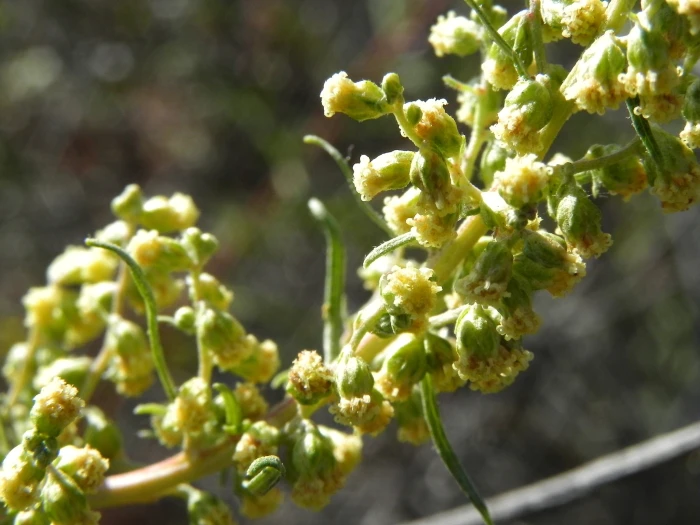San Diego Sagewort
(Artemisia palmeri)
San Diego Sagewort (Artemisia palmeri)
/
/

James Connolly Davis
CC BY-SA 4.0
Image By:
James Connolly Davis
Recorded By:
Copyright:
CC BY-SA 4.0
Copyright Notice:
Photo by: James Connolly Davis | License Type: CC BY-SA 4.0 | License URL: http://creativecommons.org/licenses/by-sa/4.0/ | Rights Holder: James Connolly Davis | Publisher: iNaturalist | Date Created: 2022-06-30T09:19:54-07:00 |

























Estimated Native Range
Climate Requirements for Rahway, New Jersey
| This Plant | Your Site | Plant Suitability for Your Location | ||
|---|---|---|---|---|
| • Precipitation | 6" - 34" | 49" | Aquatic | Aquatic |
| • High Temp. | 74°F - 96°F | 86°F | Your summer temperatures are normal for this plant. | Excellent |
| • Low Temp. | 27°F - 48°F | 22°F | Your winter temperatures may be too cold for this plant | Too cold |
This plant may not grow well at your location - your precipitation is too high.
Summary
Artemisia palmeri, commonly known as San Diego sagewort or Palmer sagewort, is a perennial or biennial herb native to coastal sage scrub and chaparral habitats, as well as riparian zones in northwestern Baja California and southwestern California, especially within San Diego County. It thrives in the Cuyamaca Mountains and other Peninsular Ranges at elevations below 1969 feet. This species typically grows 3 to 10 feet tall and features long, narrow, deeply lobed leaves that are aromatic when crushed. The inflorescence is composed of pale yellow glandular disc florets that bloom from June to October, attracting a variety of pollinators.
San Diego sagewort is valued for its wildlife support and use in native plant gardens, where it can serve as a natural pest repellent due to its aromatic foliage. It is well-suited for xeriscaping, requiring minimal water once established, and prefers well-drained soils in full sun to part shade. While not commonly used in formal landscapes, it is an important component of habitat restoration projects. Gardeners should note that it can spread readily by seed and may become weedy in some conditions. It is endangered in its native range due to habitat loss and urban development.CC BY-SA 4.0
San Diego sagewort is valued for its wildlife support and use in native plant gardens, where it can serve as a natural pest repellent due to its aromatic foliage. It is well-suited for xeriscaping, requiring minimal water once established, and prefers well-drained soils in full sun to part shade. While not commonly used in formal landscapes, it is an important component of habitat restoration projects. Gardeners should note that it can spread readily by seed and may become weedy in some conditions. It is endangered in its native range due to habitat loss and urban development.CC BY-SA 4.0
Plant Description
- Plant Type: Shrub
- Height: 3-6 feet
- Width: 3-5 feet
- Growth Rate: Moderate
- Flower Color: Yellow
- Flowering Season: Spring, Summer, Fall
- Leaf Retention: Deciduous
Growth Requirements
- Sun: Full Sun
- Water: Low
- Drainage: Fast
Common Uses
Deer Resistant, Drought Tolerant, Low Maintenance
Natural Habitat
Coastal sage scrub, chaparral, and riparian zones in northwestern Baja California and southwestern California
Other Names
Common Names: Palmer’s Sagewort, San Diego Sagewort, Palmer’s Wormwood
Scientific Names: Artemisia palmeri, Artemisia palmeri, Artemisiastrum palmeri, Seriphidium palmeri
GBIF Accepted Name: Artemisia palmeri